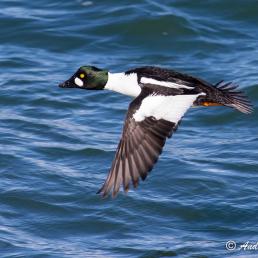

Join BirdNote tomorrow, November 30th!
Illustrator David Sibley and actor H. Jon Benjamin will face off in the bird illustration battle of the century during BirdNote's Year-end Celebration and Auction!
The critically endangered Eoörnis of the Gobi Desert was first described in scientific literature in the late 1920s. This bird is known informally as the Woofen-poof — because of the sound it makes when it takes off from the desert sand. It is easily recognized in flight by its semi-circular wings and characteristic wing whistle. Though the species was likely widespread historically, there have been no adequately documented sightings of the Woofen-poof this century. It may well be extinct.
BirdNote®
Eoörnis - A Bird of the Gobi Desert
Written by Rick Wright
This is BirdNote.
The critically endangered Eoörnis [EE-oh-OR-nis] of the Gobi Desert was discovered in the late 1920s by a scientific expedition led by Brigadier General Sir Cecil Wemyss-Cholmondely [WEEMS – CHUM-lee].
Historically, the species was widespread, according to the expedition’s naturalist, Augustus C. Fotheringham. It has been identified in 30,000-year-old cave paintings in France. While in the eighteenth century, Thankgod Pillsbury, the doctor on Captain Cook’s voyages, records dining on the bird’s eggs in the South Seas.
It’s known informally as the Woofen-poof, because of the sound it makes when it takes off from the desert sand. At close range, the bird’s identified by its long, dagger-straight bill and large throat pouch. It is easily recognized in flight by its semi-circular wings and characteristic wing whistle, pitched three octaves above middle C.
Sadly, though, with no adequately documented sightings of the species this century, the Woofen-poof may well be extinct. One possible reason for its decline was discovered in an experiment Fotheringham conducted. A captive individual, deprived of all sustenance for a week, was set down exactly halfway between two equal-sized piles of its favorite fruits; unable to decide which to eat first, it soon starved to death. Such indecision may have sealed this species’ fate forever.
For a full description, including tragically evocative photographs, see Fotheringham’s monograph.
###
Bird sounds provided by The Macaulay Library of Natural Sounds at the Cornell Lab of Ornithology, Ithaca, New York. ML193205 as ambient recorded by D. McCartt.
BirdNote's theme music was composed and played by Nancy Rumbel and John Kessler.
Producer: John Kessler
Executive Producer: Dominic Black
© 2016 Tune In to Nature.org April 2016/2020 Narrator: Michael Stein
ID# aprilfool-02-2016-04-01 aprilfool-02
Many thanks to George Lapennas for the inspiration for this story!



